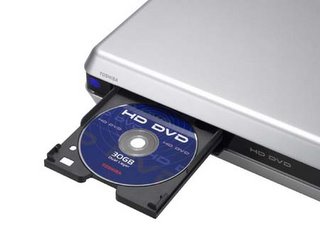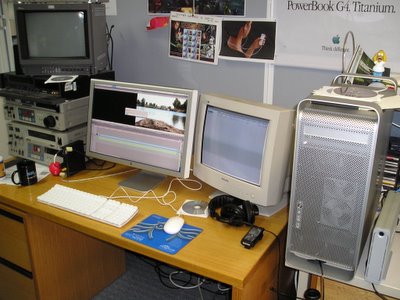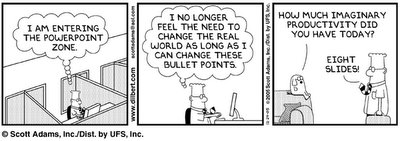
ok here is my spin.....The smart money will wait out the standards war before buying a high-definition DVD player.
If you were lucky enough to get a fancy HDTV set, you're probably eager for a high-definition DVD player to go with it. Note that the SONY 40" V SERIES BRAVIA LCD TV , is one of the very few TV's in Australia that can support true HD with a native Display Resolution: 1366 x 768, and it was only released late last year in November 2005.
But remember the Betamax! Consumer electronics is an industry notorious for rapid change and 2006 is already shaping up as a particularly disruptive year. Some of the changes will be incremental -- new phone features, lower prices for TVs -- but a standards war in DVD players and recorders has the potential to render some of the first players obsolete. Not only that, these new players have digital rights management (DRM) features that make Darth Vader look tame, more on DRM later.
Today's DVD players and recorders are based on red lasers, which read and write millions of little digital data pits on those shiny DVD discs. But the sun is setting on red-laser DVDs, because the relatively long wavelength of the red laser limits the capacity of a standard-size DVD disc, just as the world is making the transition to high-definition movies and television.
Blue lasers have a shorter wavelength, and thus can read and write much more data on the same-size DVD disc -- nearly 50 gigabytes on one type of double-layer blue-laser disc, more than enough for playing back a high-def movie or recording two or more hours of a high-def TV show.
Don't be a casualty of the standards war
Pioneer just announced that it will start selling blue-laser DVD drives for computers in Japan in just a few weeks, and in the United States by summer, making it the first to offer mass-market HD-capable DVD players and recorders to the public. Most of the major movie studios have promised to
have a selection of high-definition DVD movies available when the new drives arrive.
It will take many years for blue-laser DVDs to completely replace red-laser DVDs at your local Blockbuster, but as the world inexorably moves toward a high-definition future, red laser players are headed for obsolescence or so they would like you to believe.
The big problem is that two rival camps are competing to set the standards for blue-laser DVDs, and, just like earlier format wars -- Betamax versus VHS, Windows versus Mac, XM versus Sirius satellite radio, et cetera -- the two formats, known as Blu-ray and HD DVD, are incompatible.
A majority of major movie studios and many of the world's leading consumer electronics companies are backing the Blu-ray camp, led by Sony. The new Pioneer computer drives are based on the Blu-ray format.
Toshiba and NEC are leading the charge for the HD DVD format, and its backers include Warner Bros., HBO and New Line (like FORTUNE and CNNMoney, all divisions of Time Warner), as well as the dynamic PC duo of Microsoft and Intel.
A number of consumer electronics, computer and entertainment companies are supporting both formats for now, hedging their bets until a clear winner emerges.
The oddsmakers favour Blu-ray, in part because Blu-ray appears to have superior technical specifications and now has a head start over HD DVD in the race to market.
Blu-ray has a greater theoretical capacity than HD DVD (50GB versus 30GB for double-layer discs, as against 9GB for current red-laser DVDs), and Sony has said it will include a Blu-ray DVD drive in its forthcoming PlayStation 3> entertainment console, which, if the PS3 is as successful as the PS2, could
populate the world with millions of Blu-ray DVD players and sway any holdout movie studios to the format.
On the other hand, HD DVD supporters say their format makes it easier and cheaper to manufacture drives that are compatible with previous DVD and CD formats, lessening the cost and disruption of moving to a new HD format.
That's particularly important in the cut-throat PC business, and one reason Microsoft, Intel and HP have aligned with the HD DVD camp. (Apple and Dell, the world's largest PC maker, appear solidly in the Blu-ray camp.)
Microsoft is building HD DVD support into its next-generation version of Windows, called Vista, and presumably it wants HD DVD drives to be available for computers when Vista rolls out later this year. We can expect to see HD DVD players and recorders for home entertainment systems appear in stores
and in PCs in 2006, although the timing is unclear at this writing.
Now for the real issue of DRM. All these players have a specification for being online 24/7, that's right, they must have a Internet connection in order for them to even operate. So no net, no play. Every time you put in a disc, the player calls home and checks if its valid. What happens if you put in a non valid disc? Your player shuts down.. And you will have trust Sony or whoever to unlock it for it. Not only that it can be any non valid content (you home movie of your Xmas holiday). It gets better not only will your player shut down, the player will also send commands to anything it can control to shut that down too.. TV, stereo, hard drives... Whatever it can talk to. And we are to trust SONY to unlock it all for us? I think not.
I can see the consumer backlash on this feature alone will be enough to shut down the whole HD blue ray DVD war before it even begins.
The wildcard in all this is China. China has outlawed the use of any of the HD proprietary devices from Sony, Toshiba etc and, and come up with its own HD DVD standard based upon open standards, and based upon red laser technology using a superior CODEC chip to ones used today. In theory this could be used in any standard DVD player today with a chip swap out.
The bottom line
If you're not a big movie buff, and are happy with the quality of current prerecorded DVD movies, and if current generations of CD and DVD are sufficient for your backup and data transfer needs, sit tight.
The first blue-laser drives are certain to be expensive. Early adopters can expect to pay $1,000 or more for player-recorders, just as they did when red-laser DVD players were new. But today, basic DVD players are selling for as little as $30.
And lets not forget that less than 10,000 people in Australia are even capable of watching HD, as less than 10,000 TRUE HD TV sets have been sold in this country. Sales of True HD sets will pick up this year, industry is expecting every 1 in 25 sets sold this year will be true HD sets. Still this will not be a huge number of HD capable sets by the end of this year.
I seriously think the whole movement of little discs for video and data is rapidly approaching obsolescence. I'm betting on high-definition video-on-demand services, 100-megabit Internet pipelines and terabyte-size home media servers to make physical DVD players largely irrelevant within a decade, yes even in Australia, as wi fi services make a large presence in the next 5-10 years, with speeds over 100MB's via the airwaves.
One only has to look at the Apple business model of the distribution of audio and now video via its itunes store to realise the end of the local video store is near.
So sit back people and watch the rich elite buy stuff that will look like quadraphonic stereo sets ( a competitor to stereo in the mid 1970's that never went anywhere) by the end of the year.
2006 looks a year to sort the HD DVD industry out once and for all.





